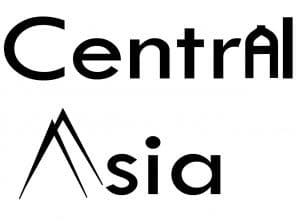Kyrgyz Food
Traditional Kyrgyz food
Traditional Kyrgyz food is a combination of ancient and medieval nomadic cultures of the Kyrgyz people that borrow dishes and recipes from more than 80 cultures and nationalities living in Kyrgyzstan, as well as the neighboring countries of Kazakhstan, Uzbekistan and China. The lifestyle of the nomads included a constant movement from place to another in the steppes and mountains, both in cold and warm weather. Therefore ancestors’ food was high in calories and very nutritious. Most of the current Kyrgyz food recipes have been passed down from generation to generation and are a vital part of the Kyrgyz cuisine.
The basis of the nomadic Kyrgyz food were earlier mainly meat and dairy products with barley and common wheat in the form of cereals and less often – jugar (sorghum genus). Grain and wheat flour were also used when available. The meat eaten in Kyrgyzstan is mainly lamb or mutton, horse and sometimes goat or yak (especially among the Pamir Kyrgyz). Most foods are prepared by boiling or fried in large pots called kazan.
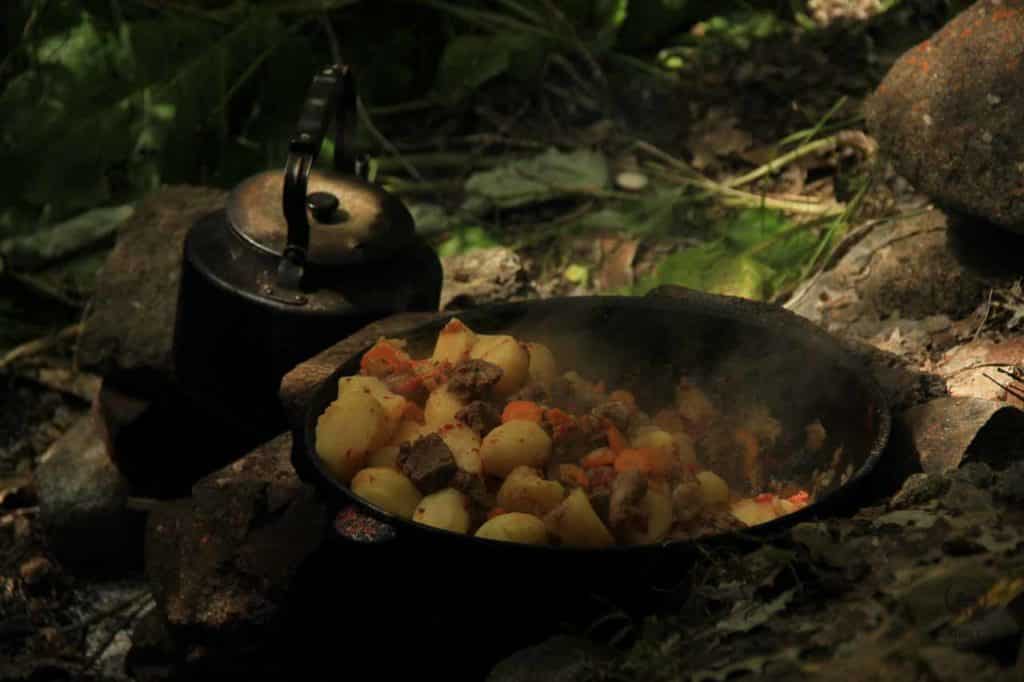
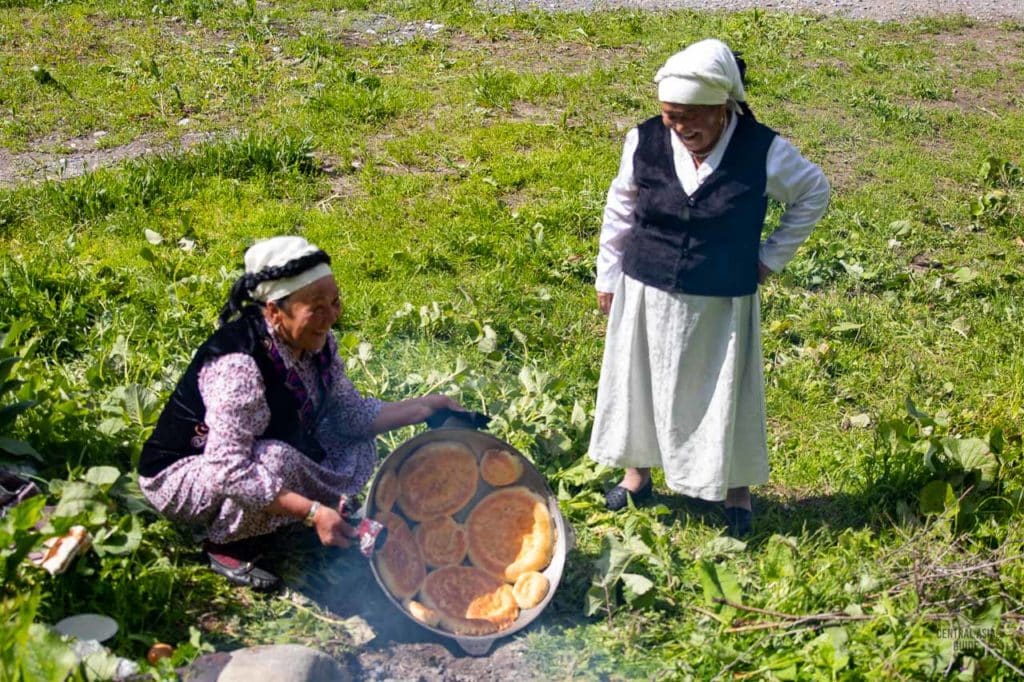
More than anything else, most Kyrgyz greatly enjoy animal fat, particularly that of the fat-tailed sheep and from the Kyrgyz prospect, the more animal fat a dish contains, the better. Such a high-fat diet suits a tough, physical lifestyle especially in the higher regions where winters can be long, cold and harsh. This means that low- cholesterol cuisine certainly is not a characteristic of the Kyrgyz kitchen. If you a vegetarian in Kyrgyzstan you may face some difficulties but there is always the option to purchase fresh fruits, vegetables and fresh bread from one of the many small stands or food bazaars that are ubiquitous in every city or eat in the many Chinese restaurants (Only in Bishkek and Osh). However, if you are visiting a village the only options are usually meaty ones with bread, tea and the occasional vegetables depending on the season.
In Kyrgyz culture, several special dishes are associated with special events and religious holidays. This linked with a tradition of overwhelming hospitality means that some dishes for the national holidays might be prepared with great piety and even ceremonial features. For instance, during the Nooruz it is required to have a “Sumolok” on the table and for the New Year it is a must to have a “Olivie” salad, adopted from Russian culture. Kyrgyz hospitality values having a great storage in providing food for honored guests. Meals are traditionally server from a large low table called a “dostorkon” that the guests surround sitting in the carpet covered floor.
Table of Contents
Kyrgyz Dishes
Beshbarmak (Five Fingers)
Besh Barmak is usually served during special occasions. Since ancient times, the Kyrgyz have given great importance to serving meat. The main thing here is called “tavak tartuu” (distribution of parts of a cut ram). Each part of the meat is divided into “ustukans” (bones with meat) which are distributed strictly according to the seniority of the guests. Filed in the wrong or violation of the hierarchy could destroy the relations of the tribes and even turn them into irreconcilable enemies. Even today Kyrgyz people make sure to follow this rule and unfortunately, not following it may still ruin the relationship. For instance, the head of the sheep always goes to the most honored guest.

The ritual preparation is precise, from the killing of the sheep to its presentation. Beshbarmak is the main meal in Kyrgyz cuisine which was popular within the nomadic people. The name of the dish in translation means “five fingers” as they mix it with noodles by hand and eaten by hand.
The dish is cooked from the fresh meat which means that a sheep is killed, butchered and boiled in the pot. It is one of the main special-occasion food and you can find it in the Kyrgyz restaurants, although there a dish with finely chopped meat, noodles and onion sauce rather than whole boiled sheep.
Kulchatai
Kulchatai is slightly similar to Beshbarmat, but with a thinly sliced square-shaped layer of dough. The dough is prepared in the same boiling pot but after the meat is removed. Kulchatai is served on a big plate, with the cooked dough at the bottom and the meat on top of it. Kulchatai is especially popular in the Talas region due to the proximity of Kazakhstan.
Animal intestines
It is common in Kyrgyzstan to eat sheep, cow and horse intestines. For a foreigner, the taste may seem a bit different (strong), nevertheless, keep in mind if your stomach is ready for it or not so you won’t upset your stomach.
The intestines are boiled along with most of the meat from the sacrifice for three or four hours before bringing it to the table. Today intestines also can be purchase in the bazaar, for instance in Osh bazaar in the meat section you can find all the part of of different animals

Adopted Kyrgyz Dishes
Kyrgyzstan hosts over 80 different cultures and nationalities. Unsurprisingly, its diverse multi ethnic environment has influenced a variety of national cuisines and beverages, particularly from Dungan, Korean, Kyrgyz, Russian, and Uzbek traditions. Many of the dishes below are also common in other Central Asian states.
Plov
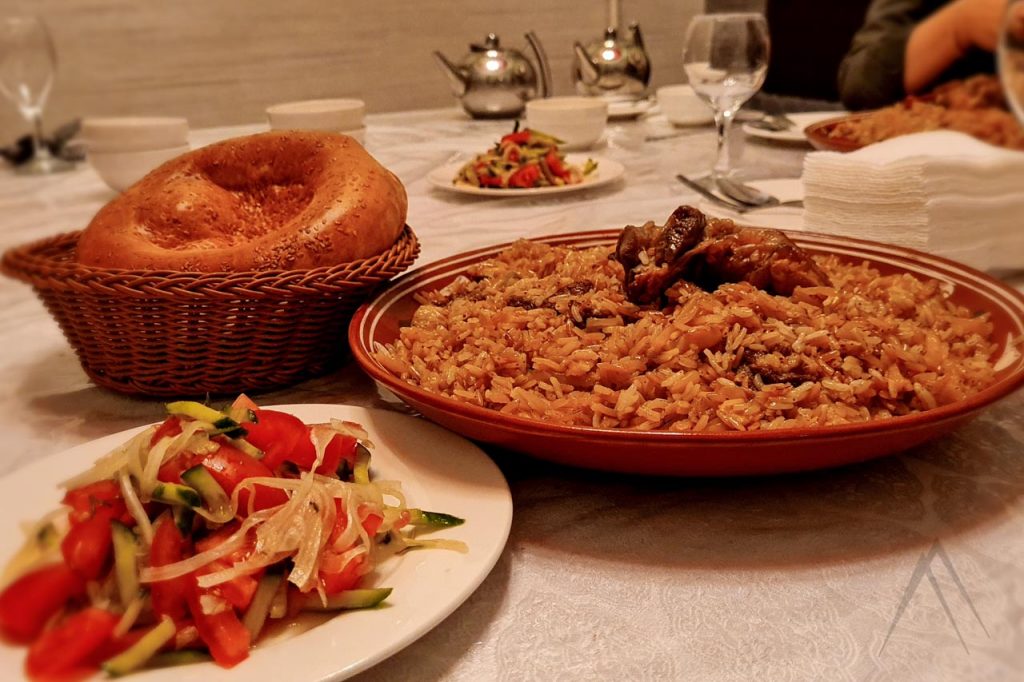
Plov is a traditional Central Asian dish that comes from the Ferghana Valley and is widespread in all Kyrgyzstan. The basis of the dish are rice, carrots and meat, first fried and then slowly cooked. Usually, lamb or beef meat (but sometimes cooked from chicken). There is no canonical recipe for cooking plov and practically every region has its recipe.
Additional ingredients such as garlic, raisins, dried apricots, nuts, etc. can be added. However, the most delicious is the plov considered when it is made from Uzgen rice, which is grown only in Uzgen and Osh regions in Kyrgyzstan.
Manty
Manti is another popular dish of Kyrgyz cuisine, dough filled with meat, prepared on steam. This is a traditional Central Asian dish with roots in the Chinese kitchen.
In Kyrgyzstan, the most common way of preparing manty is to fill it with finely chopped lamb or beef with onions. However, sometimes the meat is replaced with pumpkin or garlic chives (zhusai). Vinegar is used as a seasoning for manty and you can add some spiciness by including a chili mix over the mantys.
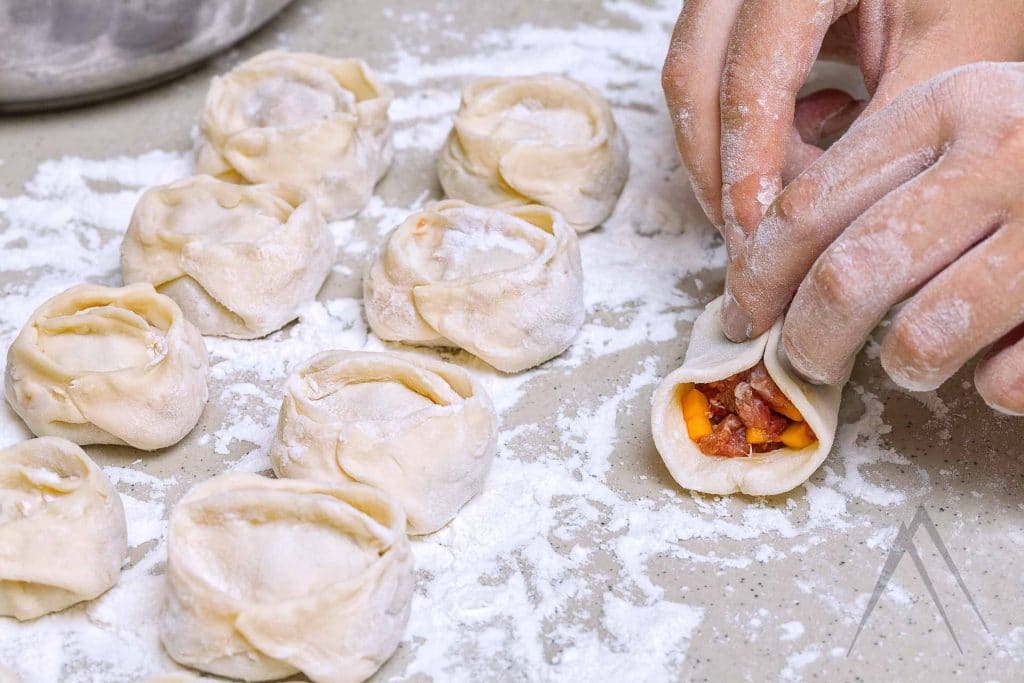
Ashlan-Fu

Karakol is the home of Ashlan-Fu. It is a spicy, cold, Dungan soup, made from two different kind of noodles, thick white rice noodles and thinner wheat noodles, mixed with a vinegar chili sauce and topped with a spoonful of chopped herbs.
To support the meal, Ashlan-Fu normally comes with a side of piroshki (fried bread stuffed with potatoes). You can find this dish all over Karakol, from restaurants to stand-up stalls and especially in the bazar. This is the must try food if you are in Karakol.
Ashlan Fu can also be found in Bishkek but it is most authentic in the Issyk Kul region.
Lagman
Lagman is a very popular noodle dish. It is prepared from thick noodles with meat and vegetables and served in spicy vinegar sauce.
There are different types of Lagmans such as Bozo lagman (fried lagman) and Guiru lagman (a more liquid lagman, almost a soup). Lagman is originally considered a Dungan or Uyghur national dish but served virtually everywhere in Kyrgyzstan.
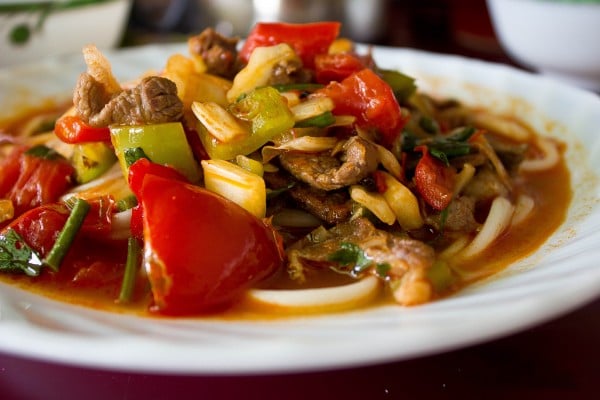
Samsa
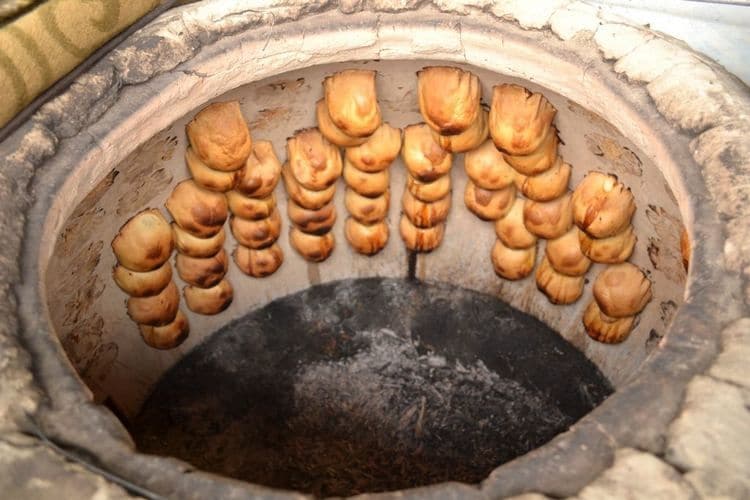
Samsa is a hollow, baked dough bread roll, usually filled with lamb meat, animal fat and onions. However you may find meat replaced with potato or pumpkin as well. Traditionally samsa is baked in a tandoor, which is a clay made oven with a fire at the bottom. In the Kyrgyz cities samsa is however often prepared also in the regular oven with the triangle appearance.
The home of exceptionally good tandoor samsa is Osh and they can be also incredible in size there. They need to be eaten in a special way: with a knife, cut open the bottom part of samsa that was attached to the tandoor, then eat meat filling with a spoon, and then the dough soaked in juice piece by piece.
Kyrgyz National Drinks
Tea Culture
The tradition of the tea party has strongly entered the traditional Kyrgyz cuisine. Tea is one of the most popular drinks among Kyrgyz people. Kyrgyz people drink tea it in the morning, before and after lunch, for dinner they drink with fresh milk or cream, lightly salting it. Sometimes when offered tea, you might be asked what kind of tea you want “kok chai” green tea or “kara-chai” black tea. Also it is customary that people in Kyrgyzstan don’t fill the tea cup all the way, so the tea won’t get cold and they can be hospitable and serve you lots of tea.
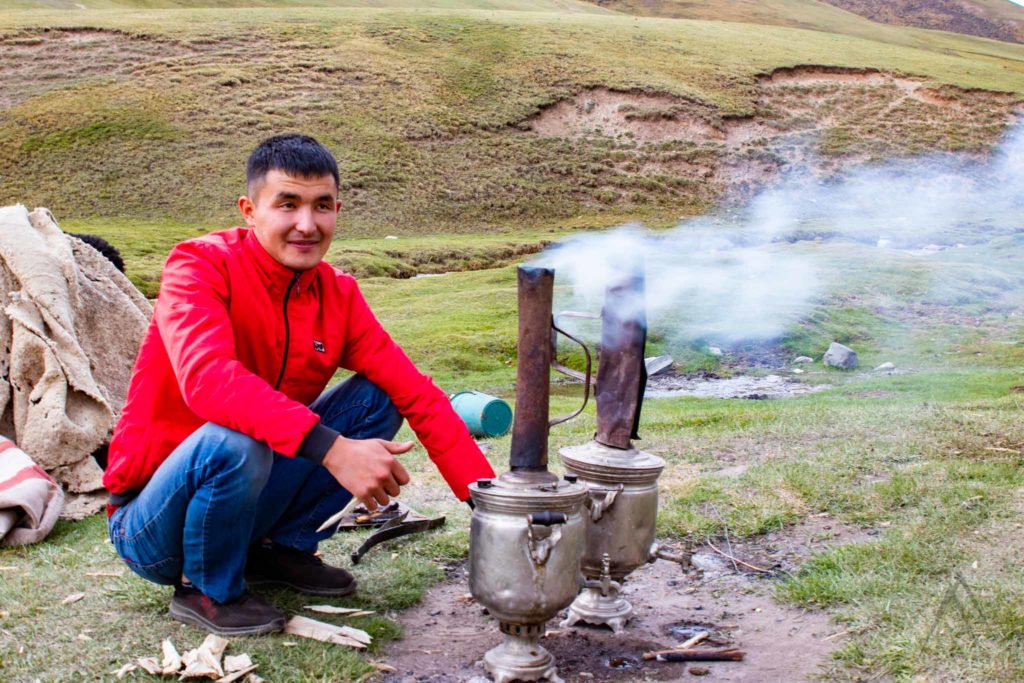
Samovar Tea in Kyrgyzstan
Tea prepared in a samovar is highly valued for its taste. Preparing tea in the samovar is popular in the mountains of Kyrgyzstan where electricity is not always available.
Kymyz (Mare's milk)
Kymyz is a traditional Kyrgyz drink produced from the mare’s milk. Kymyz is prepared only for the period from May to September, when the mare’s feed their offspring and they can be milked. Kymyz is preparad by fermenting the milk, has a tonic effect and is at the same time is slightly alcoholic (0,7 – 2,5 %) and salty.
Kymyz therapy as part of Jailoo (mountain pasture) tourism got recently popular among the locals. It is also one of the ways to experience true Kyrgyz nomad culture.
Suusamyr valley is popular with Kymyz therapy camps or Jailoo tourism where local Kyrgyz people, as well as foreigners, stay in the camps for 1-2 weeks without the comforts of modern society.
Kyrgyz people believe in the benefits of kymyz for health and they can drink fresh kymyz every day. Foreigners with a stomach not used to the unfamiliar bacteria of the fermented mare milk should be careful with the amount of consumption of this local delicacy.
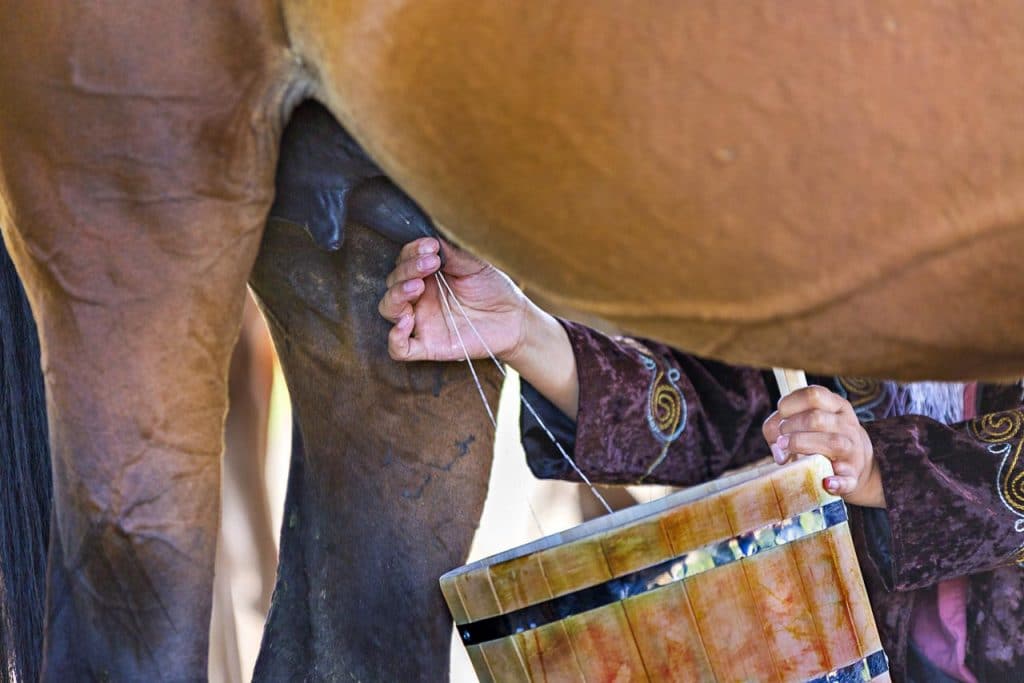

Kymyz preparation process
As one might guess, the kymyz preparation starts by milking the mare. There is a special way of increasing the yield of horse milk by letting the foal first drink for a moment from the mare’s udder to make the milk flow first. Afterwards the milk can be gathered to a container by milking the udder.
The milk is then churned for some time and afterwards being let fermented inside a skin of an animal, e.g. a goat’s skin. The skin has been smoked from inside with the smoke of Archa (Juniper) to cleanse the vessel and to provide some taste to the final milk product. Kymyz is best drank very fresh when it is less bitter.
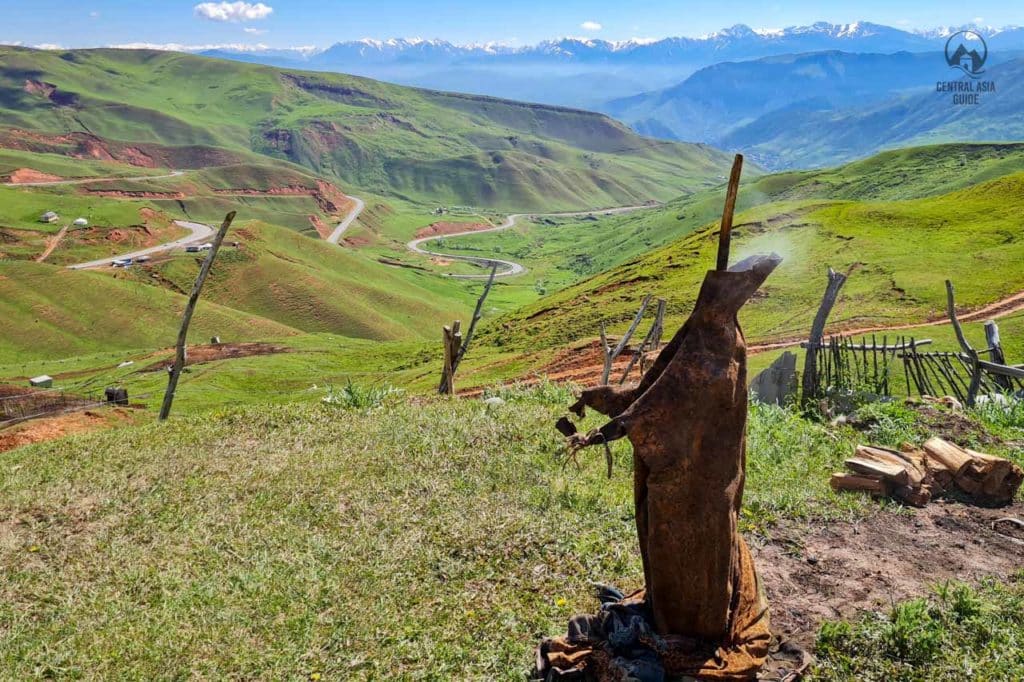
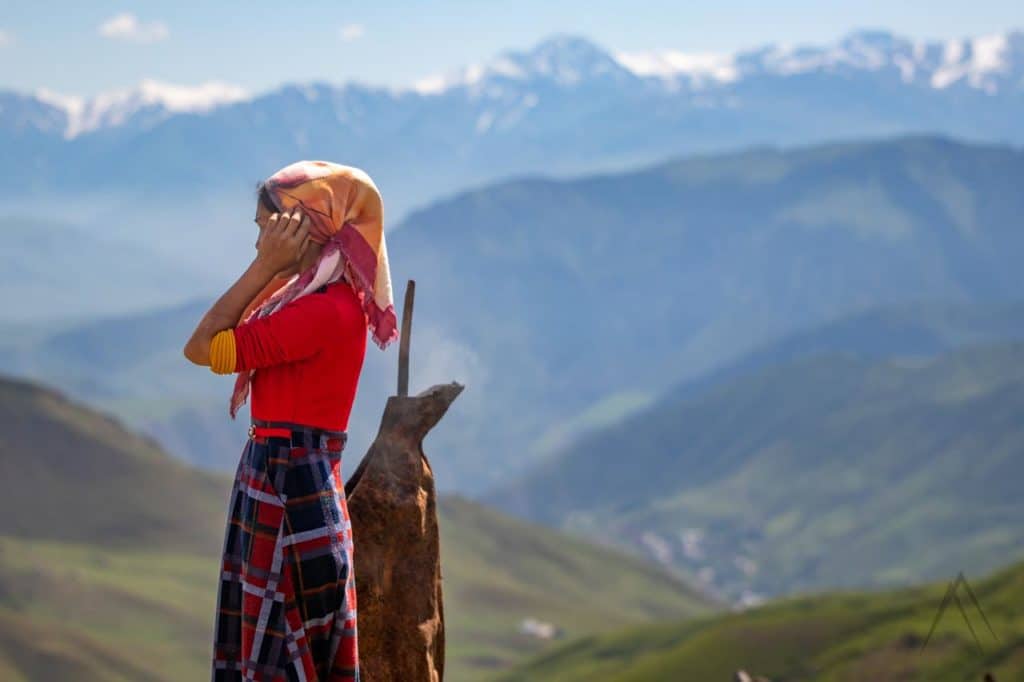
Kurma Chai
“Kurma chai” that literally translates as a “fried tea” is a drink of the ancient Kyrgyz people and is not that common nowadays. Kurma Chai is prepared by frying flour in butter and adding it into a black tea with milk. Some also prefer to add salt or sugar which can actually make this drink resemble a soup or a liquid porridge.
Bozo
“Bozo”, is prepared from millet, barley, or corn. Mostly adults and mainly in winter Kyrgyz people drink bozo .
Chalap
Chalap is a national fermented milk drink made from sour milk, water, and salt. Also widely known as tan drink from the Shoro brand.
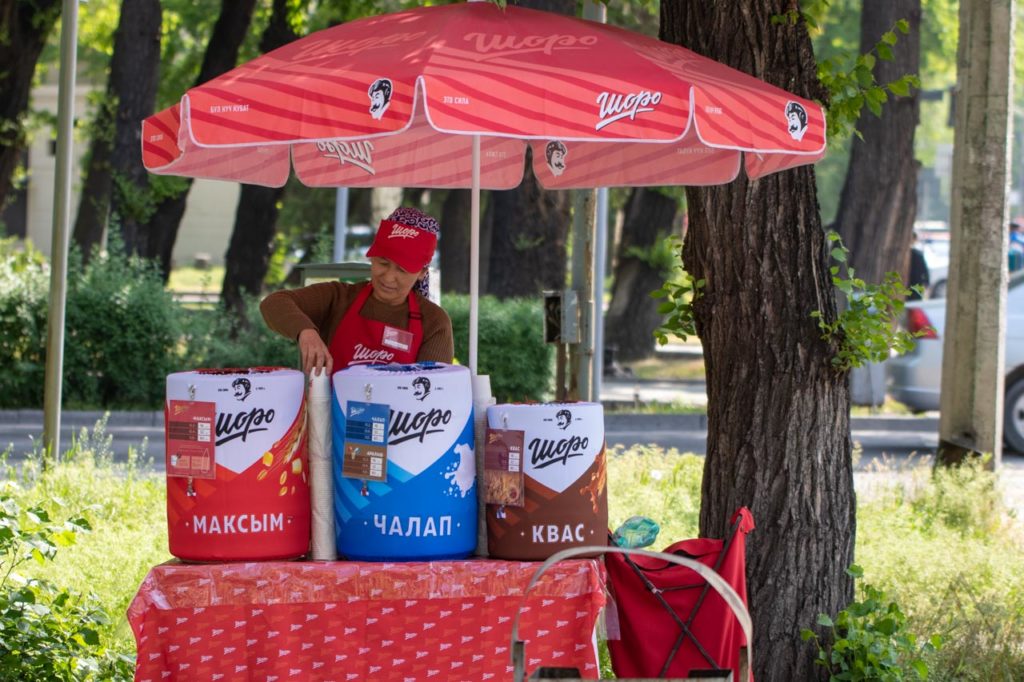
Maksym
Maksym is a slightly carbonated drink made by fermenting grain. Maksym is usually made from malt, but other types of grain can be used in its preparation. There are various cooking methods and recipes. It is made by boiling malt or another type of cereal.
Jarma
It is made almost the same as maksim, except it is not fermented, but mixed with ayran to make it slightly carbonated. The only difference is after you remove it from the heat, you will need to add one large cup of ayran (fermented milk drink, homemade kefir). Unlike Maxym, can be drunk warm.
Aralash (Mixture of maksym and chalap)
Maxim and Chalap have recently gained popularity within the locals when a commercial product at Bishkek’s Shoro company start commercialise this soft drinks. Today they are available throughout Kyrgyzstan in every shop and during the summer time in the streets of Bishkek. Some residents even like to mix Maksym and Chalap its called “Aralash” means mix from Kyrgyz language.
Kyrgyz Flour based foods
Borsok
Borsok is a piece of dough, deep-fried in boiling oil and is a traditional table “decoration” but also very delicious when fresh. Boorsok are prepared in large quantities and spread over the dastorkon (a table full of food) or table at every major party and often in smaller occasions. Borsok is oftern served with Kaimak, which reminds a thick fatty mayonnaise and the hot bread pieces should be dipped in this tasty milk product.
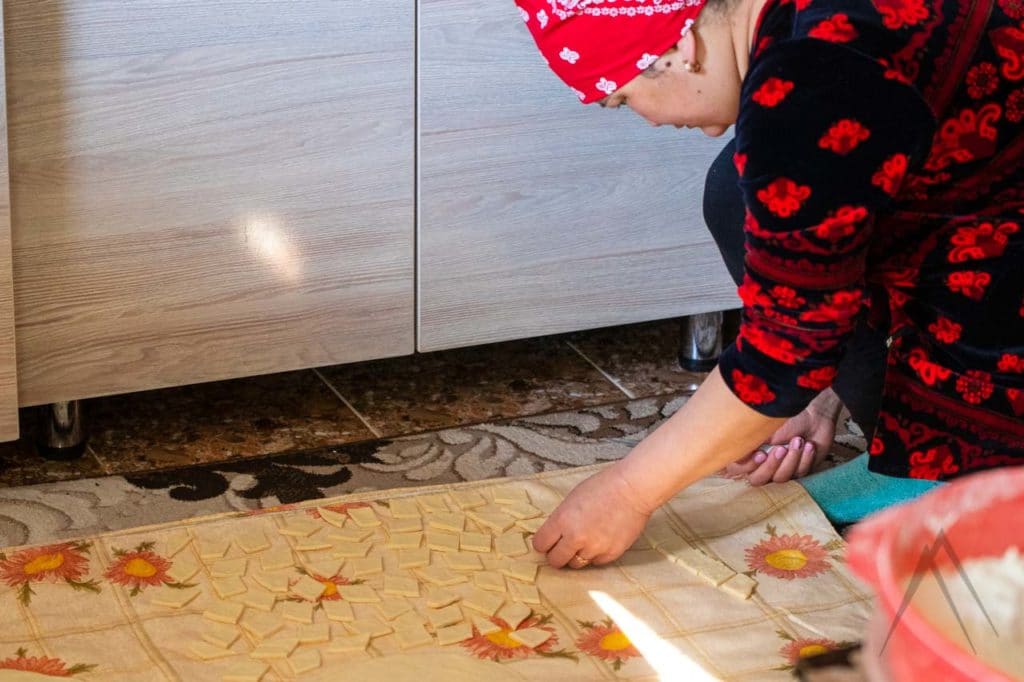
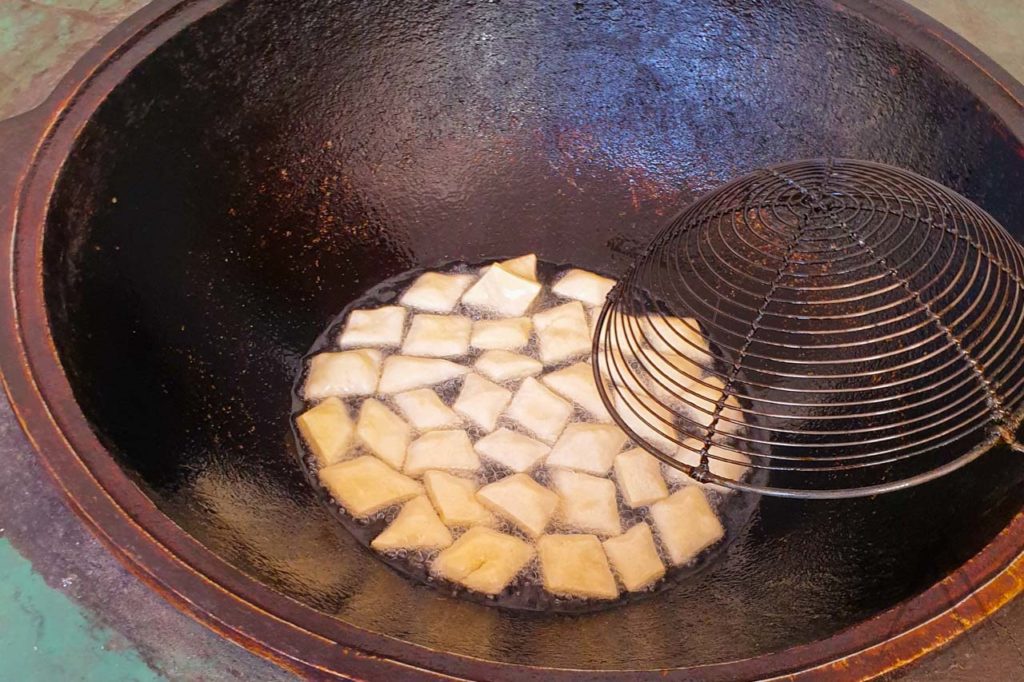
Boorsok preparation
Boorsok is prepared in every home and is best when it is served hot straight coming out from the oil. Before frying the thin dough is cut in a certain way to give the borsok its familiar shape. It is a very simple dish and locals are happy to have the foreigners to take part in preparing it.
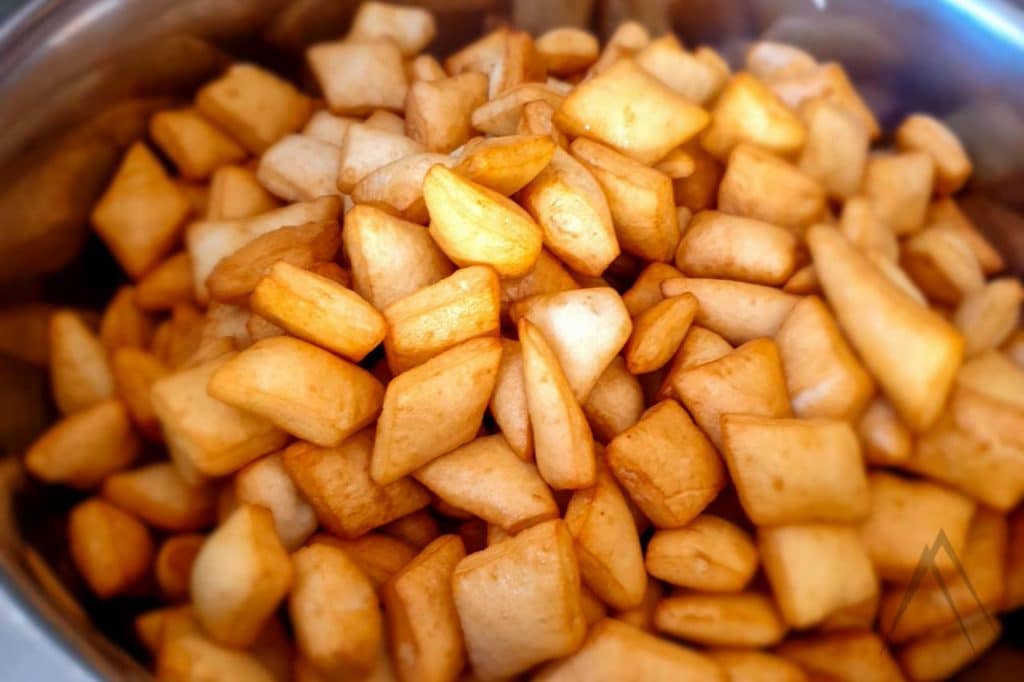
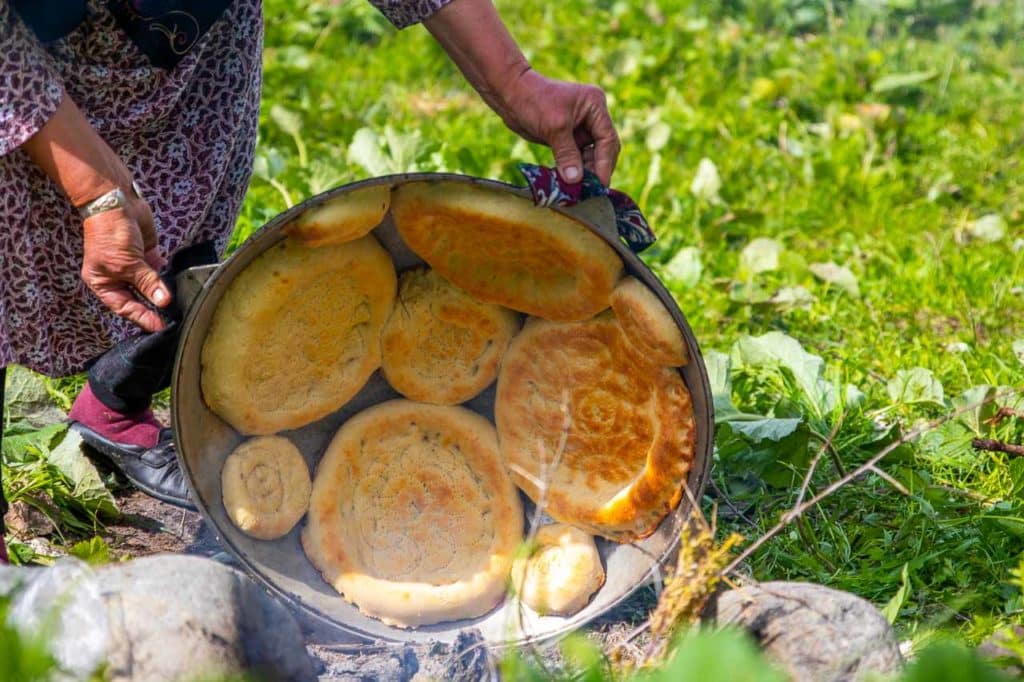
Lyapeshka (bread)
“Bread is life” is a common phrase to the Kyrgyz. Therefore, bread is never to be wasted or treated with disrespect. The most popular bread in Kyrgyzstan is the round bread called called “tandyr nan” in Kyrgyz and “lepyoshka” in Russian. This bread is at its best when it is fresh, warm, straight from the tandoor (an outdoor clay oven).
This bread is always cut by hand, not with a knife and never placed on the table upside down. A good host always offers the guest bread, even if the guest only visits for few minutes. Kyrgyz people usually eat bread with jam, kaymak, or sary mai.
Kattama
Kattama is a traditional Turkic pastry popular around Central Asian countries. It is very buttery, crispy, layered, and fried to perfection. The dough is rolled thin, slathered in butter and another filling, and then layered and folded, creating flaky layers that are both crisp and soft.
Kattama is served hot with kaymak (a creamy dairy product with a thick texture and a rich taste). You can try it in any national cuisine cafes in the country.
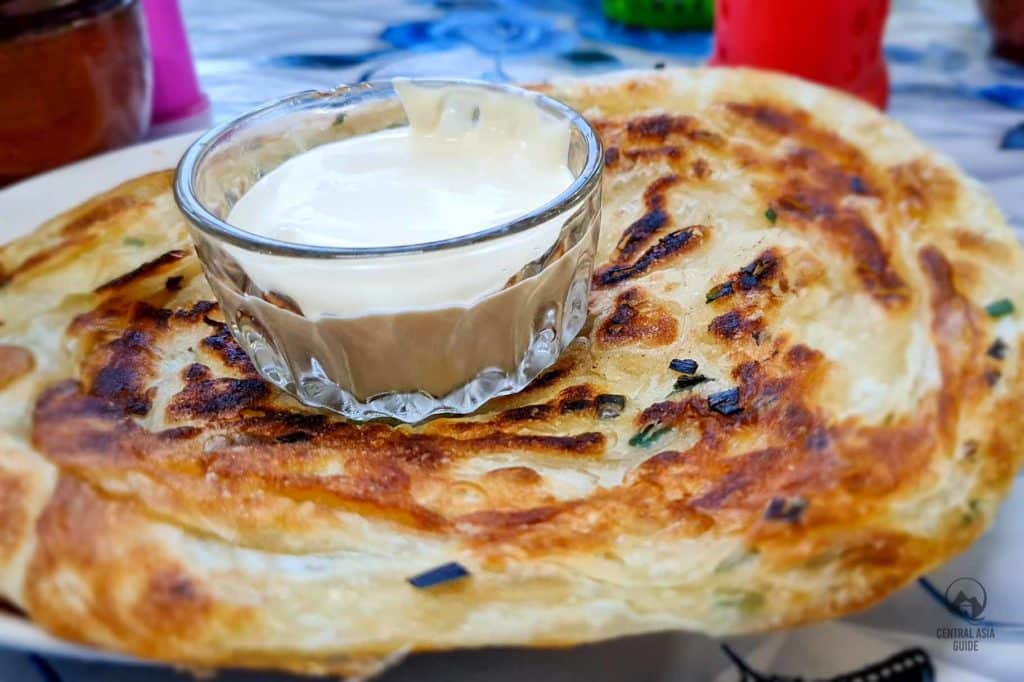
Kyrgyz Delicacies
Shashlyk
Shashlik is a barbecue dish, fried meat on skewers on open charcoal, which is pre-marinated for several hours before cooking. Shashlik is usually made from lamb, but can also be found made from chicken and beef. Pork shashlyk is not usually available as Kyrgyzstan is a mostly muslim country though fairly secular.
A traditional way of preparing Kyrgyz Shashlyk or other meat dishes is to cook it over large, thin stones with fire under them. The method is called the “Stone Barbeque” or “Kamennii Mangal” in Russian.
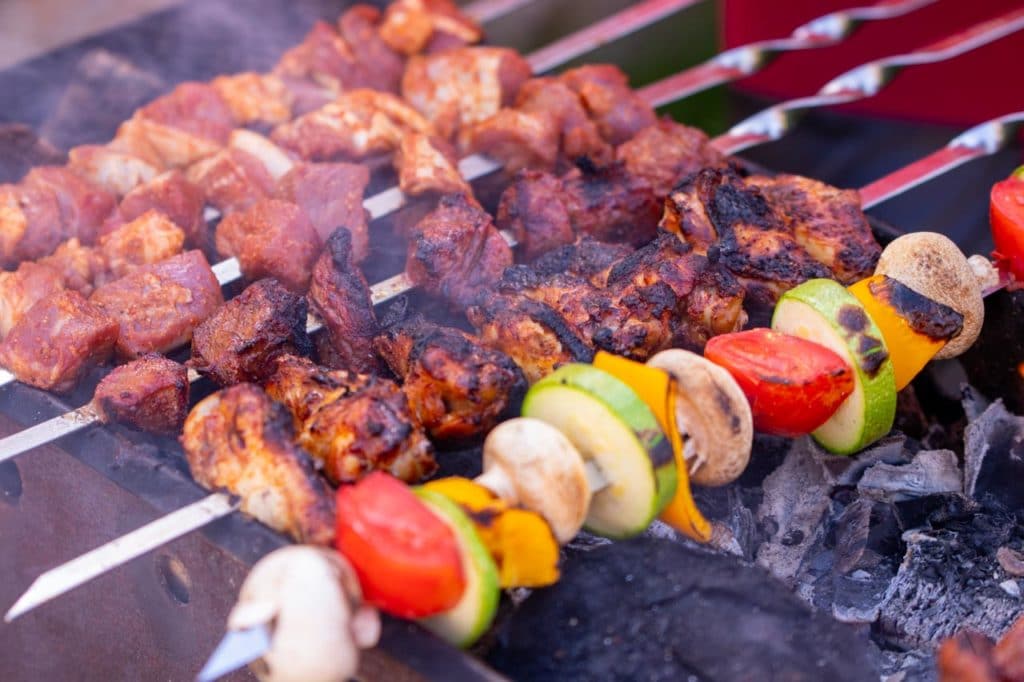
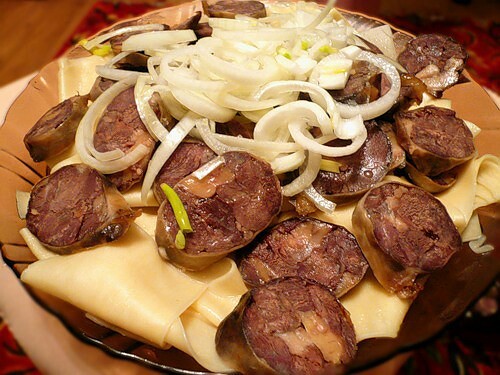
Chuchuk / Kazy
From ancient times, “Chuchuk” was considered among the Kyrgyz most delicious treats. In some regions of the country, as a sign of respect to the guest of honor, the whole chuchuk is served. Сhuchuk is made from the hypochondrium fat and horse meat.
Bizhi or Byjy
Bizhi is made of fresh blood, rice, onion and this all mix and putten inside of the intestine.
It is always made from fresh sheep’s blood that pops up right after cutting the throat. Onion chopped into small pieces and mix with white rice. Usually goes like a delicacy for the main food. Basically like blood sausage.
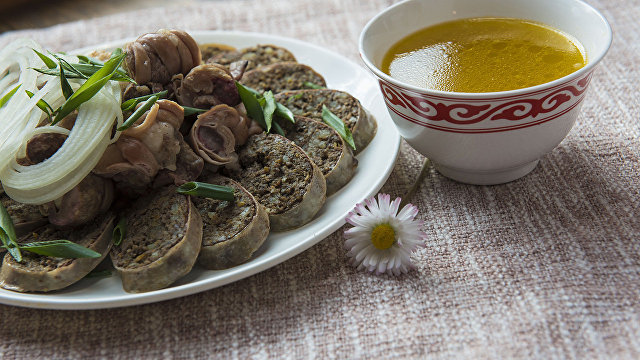

Sary Mai
The Kyrgyz have a special love for “Sary May” – ghee (butter). This salty butter is made from cow’s milk and is stored traditionally in a “Karyn” (sheep’s stomach).
The sheep’s stomach is properly cleaned with a knife blade, soaked well, and boiled before utilizing it as a traditional storage unit. Sary mai has a different texture than the more common butter and is a lot more salty but also very tasty. This treat is at its best when served to you in a remote Kyrgyz village together with fresh bread and very fresh kymyz during the spring time.
Kurut
Kurut is a milk-based snack that you will see people selling on the side of the road all over Kyrgyzstan and also in other neighboring countries. It’s strained yogurt that has been dried and mixed with a large amount of salt, rolled into balls and finally let to dry in the sun. Kurut comes in different sizes and flavors ranging from smoked ones to the ones with additional different spices. Kurut is really the favorite snack of locals as it is a cheap snack and is is to carry while you’re on the road. The taste might not suit all the foreign mouths though.
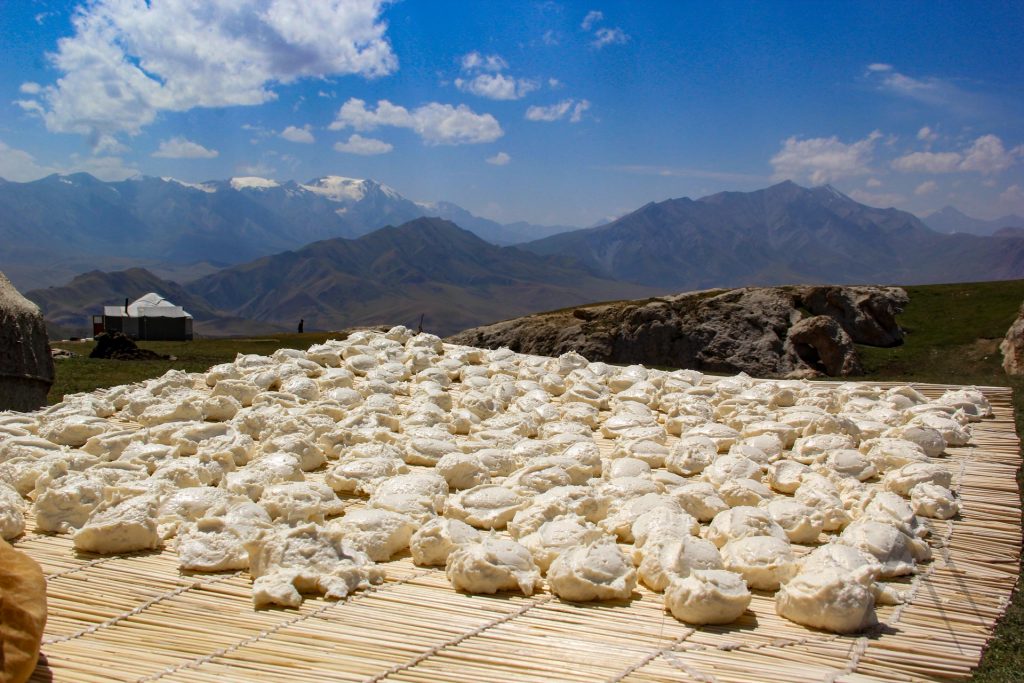
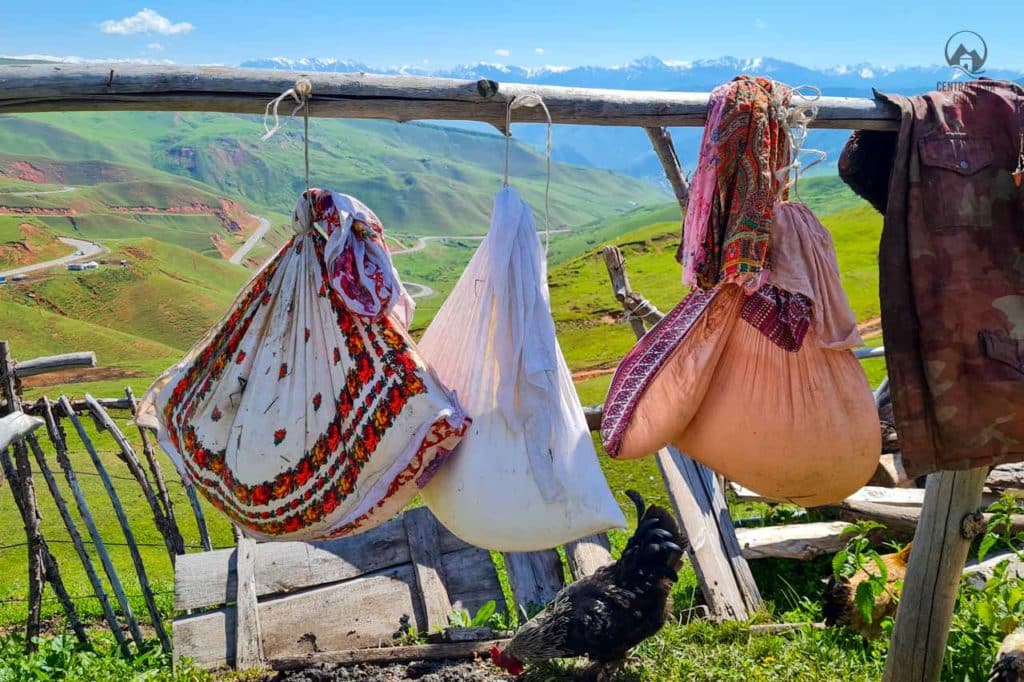
Best places to enjoy Kyrgyz food
Page updated 18.1.2021
